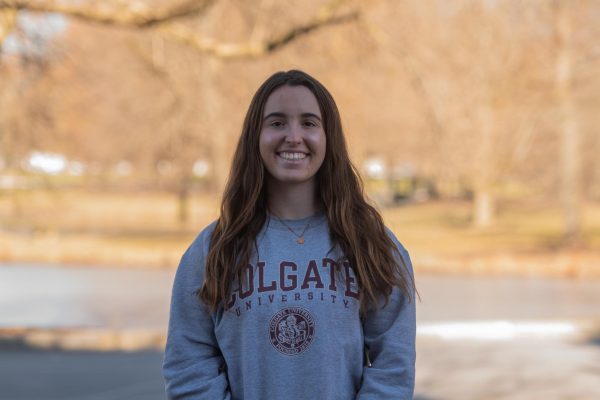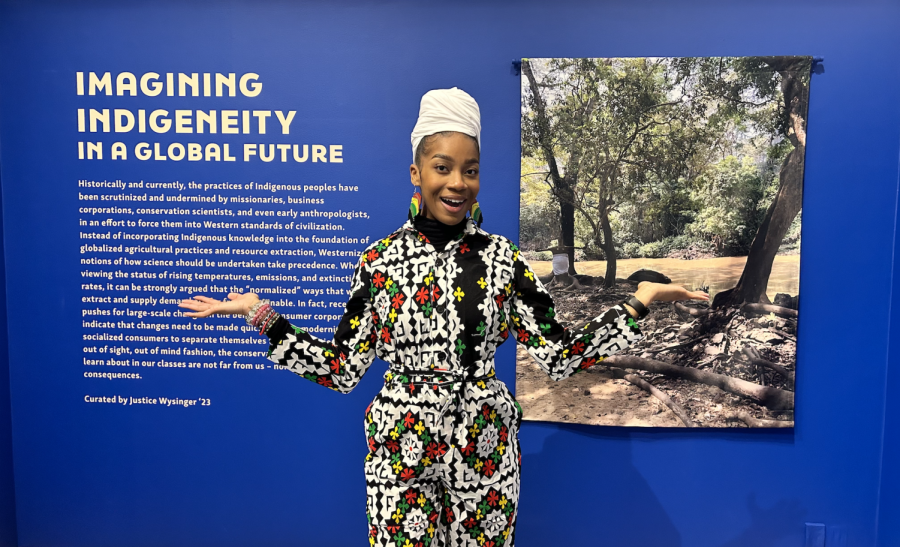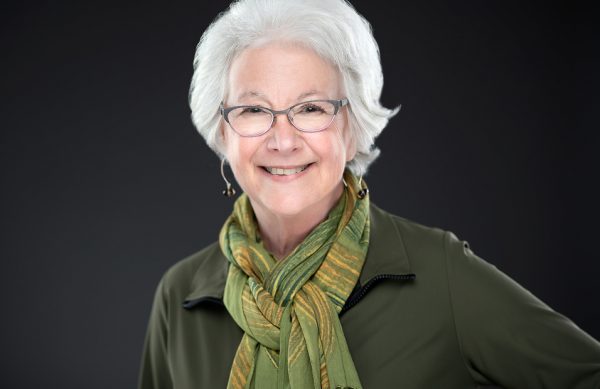New Longyear Museum of Anthropology Exhibit: Imagining Indigeneity in a Global Future
The Longyear Museum of Anthropology unveiled the work of senior Justice Wysinger on Feb. 9 in an exhibit titled “Imagining Indigeneity in a Global Future.” Wysinger’s exhibit honors Indigenous communities and recognizes the need to actively advocate for them as they are increasingly threatened by environmental effects. Many Indigenous peoples have faced displacement and have lost their native lands to the impacts of pollution or the consequences of climate change. Wysinger’s work emphasizes accountability for everyone in protecting the environment and all the communities within it.
Iya Ifatola Tifase is Wysinger’s mother and Ifa priestess. The opening began with a series of blessings, one of which was given by Tifase. Both Iya Tifase and Wysinger practice the religion of Ifa, an Indigenous African religion. The celebration of religions like Ifa inspired many of the event’s attendees, including sophomore Aby Metellus who commented on the impression the exhibit had on her.
“Coming to this exhibit today was very eye-opening, just because when it comes down to non-Abrahamic religions, they are not often talked about or praised in the same way that Christianity is or recognized,” Metellus said. “So, having an exhibit that puts Ifa, a native Indigenous African religion, on the forefront is very important.”
An important aspect of the Ifa religion is the Osun River in Nigeria. Ifa devotees bathe and drink from the river, believing it contains the Ase of Osun, or power of Osun, which can bring health and fertility. However, since 2020, the Osun River has become contaminated with dangerously high levels of lead and mercury due to gold mining in the area.
In addition to featuring artifacts from Nigeria, the exhibit features items representative of global material culture which are produced with a high environmental cost. Many products, such as maple syrup, contain corn variants, which are often mono-cropped and frequently not prepared properly to yield nutritional value. Amazon and Central American forests are destroyed for palm oil plantations. Furthermore, the pollution created by gold mining is ignored and results from illegal practices. These effects are felt more locally in Hamilton, as well, with the salt extraction surrounding Onondaga Lake. This has depleted deposits and left the sacred lake of the Oneida and Onondaga communities contaminated.
The mass exploitation and marketing of resources such as corn, salt, palm oil and gold ignores the value of these resources to Indigenous communities. For example, palm oil is considered sacred and commonly used in West African culture and religion. The pollution and environmental consequences caused by the increasing extraction of these resources expose disrespect for the environment that produces them and also for the Indigenous communities that have responsibly used and valued them.
Consumers and corporations have not only been contributing to the physical deterioration of Indigenous communities but to the deterioration of their cultures through commercializing and exploiting all aspects of their societies. This exhibit strives to honor Indigenous societies through showcasing their respect for the environment and the beautiful ways these communities use natural resources to make the objects on display in the exhibit, including baskets and molas made by the Guna peoples.
Molas are worn as a part of a woman’s upper garments. Typically, they are sewn onto the front and back of a blouse. Their creation involves delicate threading of motifs on layers of cloth. Another Indigenous community, the Guna (Kuna) women of Panama, is also threatened by environmental consequences. These women create molas, some of which were on display in the exhibit. Unfortunately, rising sea levels have forced many individuals of the Guna community to relocate. The projected intensification of climate change’s effects endangers the viability of coastal communities and their practices such as the Guna and the creation of the molas.
Splint basketry is a traditional practice in the Haudenosaunee community. It involves mindfully collecting materials, a practice where the gatherer takes the item and leaves a gift in its place. However, the pollution of the Onondaga lake since the 1800s threatens the Haudenosaunee’s ability to fish and to continue their reciprocal relationship with the land.
Wysinger’s exhibit educates attendees about Indigenous communities and how they are being impacted by collective carelessness for the environment. The emphasis on various communities across the world only expands the message of the exhibit on a global scale. First-year Abigail McGuire shared how the scope of the information provided impacted her.
“One of the most thought-provoking parts of the new exhibit was that it wasn’t just restricted to Indigenous American information and artifacts. It linked the Indigenous peoples of America with Indigenous peoples in Africa and their shared struggles, but also highlighted how they can empower each other while maintaining their distinct identities,” McGuired said.
The empowerment of identities is something that Wysinger strives to portray. She hopes to challenge viewers and confront them with realities they had yet to consider or had tried to ignore. Wysinger echoes these sentiments in explaining the meaning of her work and the norms she seeks to defy through it.
“This exhibit meant finding empowerment in my own identities and my own indigenous ways of knowing […] and that just connects to the work done in anthropology about learning about others,” Wysinger explained. “Who is the other and when does the other not become the other?”
Categorizing groups of individuals, like Indigenous communities, as the ‘other’ makes it easy to disregard the problems they face. They remain disconnected from the rest of the world that fails to hold itself accountable for its harmful actions, such as those done to the environment, that in turn further threaten Indigenous communities. This other-ization and lack of accountability are practices that Wysinger exposes within her inspiring, bold and beautiful exhibit.

Allie Kavalauskas is a sophomore from Augusta, KA concentrating in international relations with a topical concentration in Spanish and Italian. She has...







